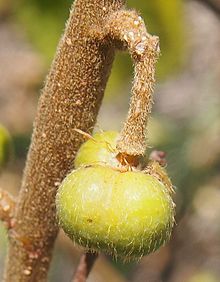Grewia retusifolia
Appearance
| Grewia retusifolia | |
|---|---|

| |
| Scientific classification | |
| Kingdom: | Plantae |
| Clade: | Tracheophytes |
| Clade: | Angiosperms |
| Clade: | Eudicots |
| Clade: | Rosids |
| Order: | Malvales |
| Family: | Malvaceae |
| Genus: | Grewia |
| Species: | G. retusifolia
|
| Binomial name | |
| Grewia retusifolia | |
Grewia retusifolia is a shrub species in the family Malvaceae. Common names include dysentery bush, emu-berry, dog's balls, turkey bush and diddle diddle.[3][4] It is widespread in tropical and subtropical areas of Eastern Australia and Northern Western Australia.[5] The species produces small, sweet, two-lobed fruit with a fibrous acidic pulp surrounding the seeds. Leichhardt described the fruits as having a very agreeable taste, which could be boiled to make a refreshing drink.[5] Indigenous Australians use the bark and leaves in medications.[4] The crushed leaves were used as a poultice to relieve toothaches.[5]
References
[edit]- ^ Liu, B.; Qin, h.; Botanic Gardens Conservation International (BGCI).; IUCN SSC Global Tree Specialist Group (2019). "Grewia retusifolia". IUCN Red List of Threatened Species. 2019: e.T147615820A147615822. doi:10.2305/IUCN.UK.2019-2.RLTS.T147615820A147615822.en. Retrieved 18 November 2021.
- ^ "Grewia retusifolia". Australian Plant Name Index (APNI), IBIS database. Centre for Plant Biodiversity Research, Australian Government, Canberra. Retrieved 2009-07-11.
- ^ "Grewia retusifolia". FloraBase. Western Australian Government Department of Biodiversity, Conservation and Attractions.
- ^ a b Low, T. (1991). Wild Food Plants Of Australia. Australia: Angus & Robertson. ISBN 0-207-16930-6.
- ^ a b c Cribb, J.W. & Cribb, A.B. (1975). Wild Food in Australia. Sydney: Fontana/Collins. ISBN 0-00-634436-4.
{{cite book}}: CS1 maint: multiple names: authors list (link)

